That’s how the month-to-month PPI readings are, full of dramatic zigzags and revisions.
By Wolf Richter for WOLF STREET.
A month ago, when the Producer Price Index Final Demand for services had massively spiked month-to-month, I mused: “Just by looking at the month-to-month blue lines in these charts, how much they zigzag, I expect further zigzags, big ones too. After a huge spike, we’ve often seen a much smaller increase or even a negative reading, and vice versa.” And that’s sort of what happened for August, because that’s just how the month-to-month PPI readings are, full of dramatic zigzags and revisions.
The July explosion of the Final Demand Services PPI of +1.08% from June (+13.8% annualized) was revised down dramatically today to a still substantial increase of +0.61% (+9.2% annualized), according to data from the Bureau of Labor Statistics today.
For August, the Services PPI declined by 0.30% (-2.9% annualized) month-to-month (blue in the chart). The six-month average, which includes all the revisions, decelerated to +1.4% annualized (red).
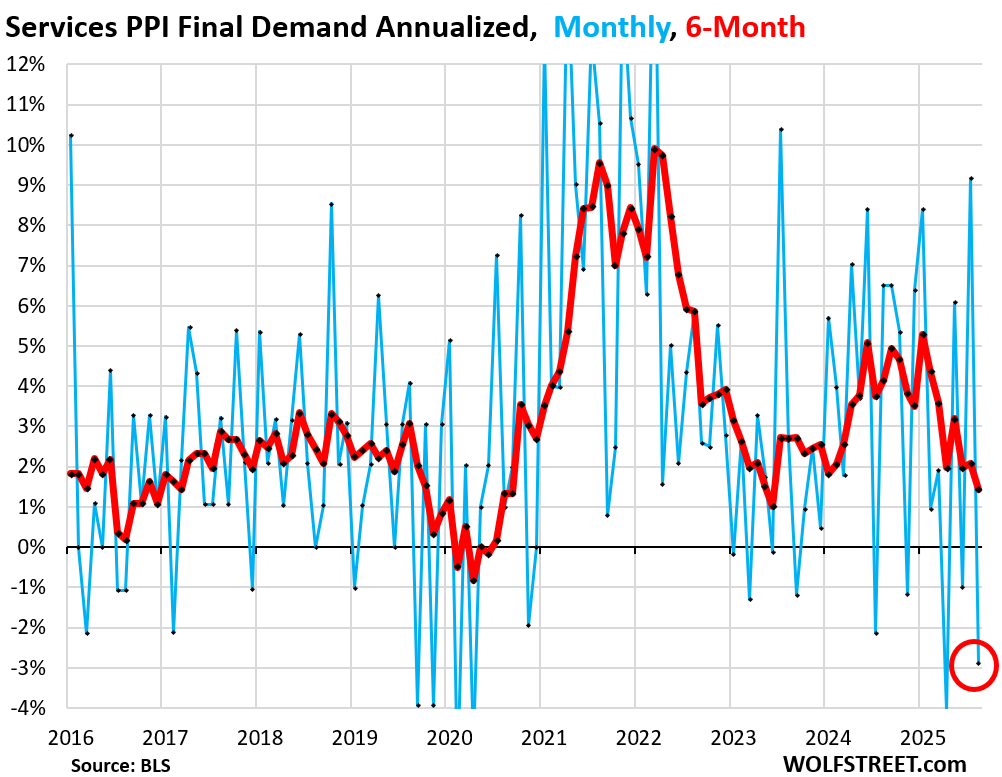
The month-to-month drop in the services PPI was driven by the 1.7% plunge (-22.4% annualized) in trade services.
But transportation and warehouse services jumped by 0.9% (+11.4% annualized). And the index for all other services rose by 0.3% (+3.7% annualized).
The services PPI dominates the “core” PPI Final Demand (which excludes food and energy) and the overall PPI Final Demand, and caused both of them to dip month-to-month.
Year-over-year, the core services PPI rose by 2.9%, undoing most of the acceleration in July.
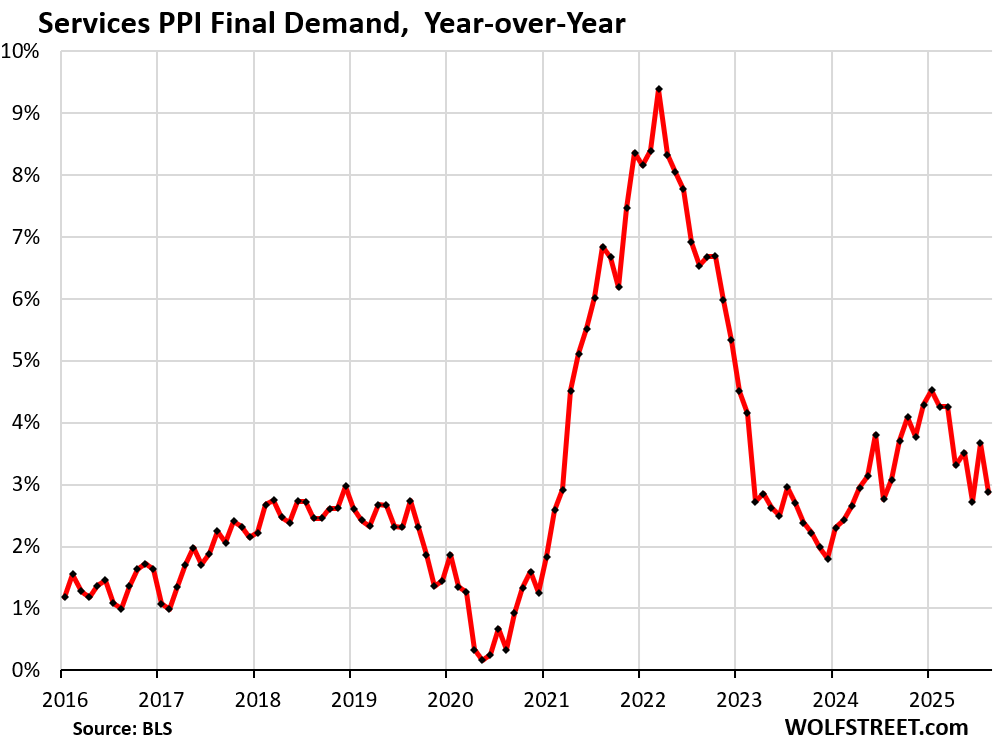
The PPI for “Finished Core Goods” accelerated in August to +0.31% (+3.8% annualized), thereby undoing the cooling in July. This measure excludes food and energy goods.
The six-month average rose 3.4% annualized in August, same as in July. Both were the worst readings since June 2023.
The tariffs paid by companies show up here indirectly. The PPI does not track import prices. It tracks prices that companies charge each other and thereby does not directly track the costs of tariffs that companies are paying on imported goods. But by tracking prices that companies charge each other, it indirectly tracks how companies eat the tariffs or pass them to other companies, and that’s where the tariffs have been ricocheting around, as companies are having trouble passing them on to consumer prices.
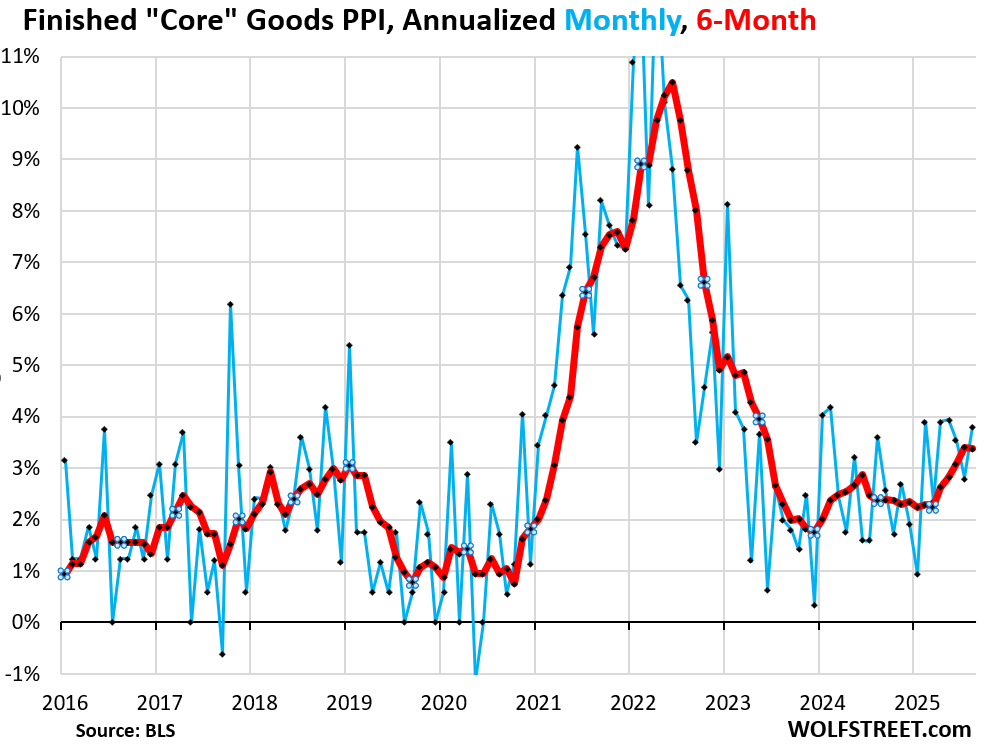
Year-over-year, the PPI for finished core goods accelerated slightly to 2.84%, the worst since June 2023.
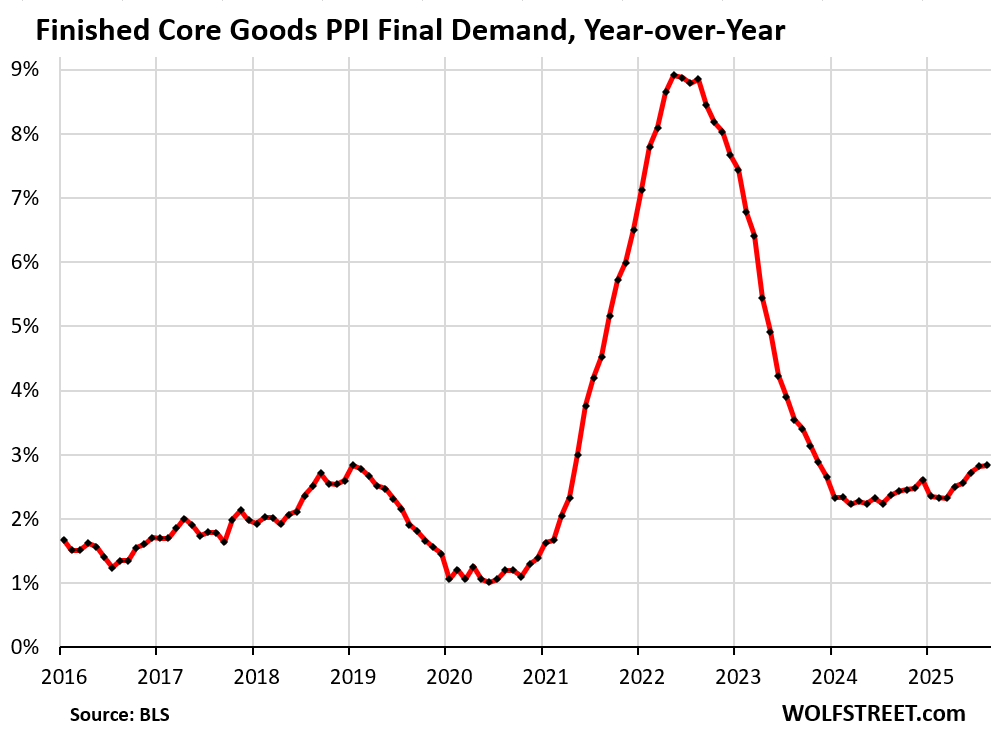
“Core PPI Final Demand, which includes all goods and services except food and energy, is dominated by the services PPI. So like the services PPI, the spike in July was revised down (from +0.92% to +0.65%).
August dipped by 0.12% (-1.4% annualized) from July. The six-month average decelerated to +1.9%.
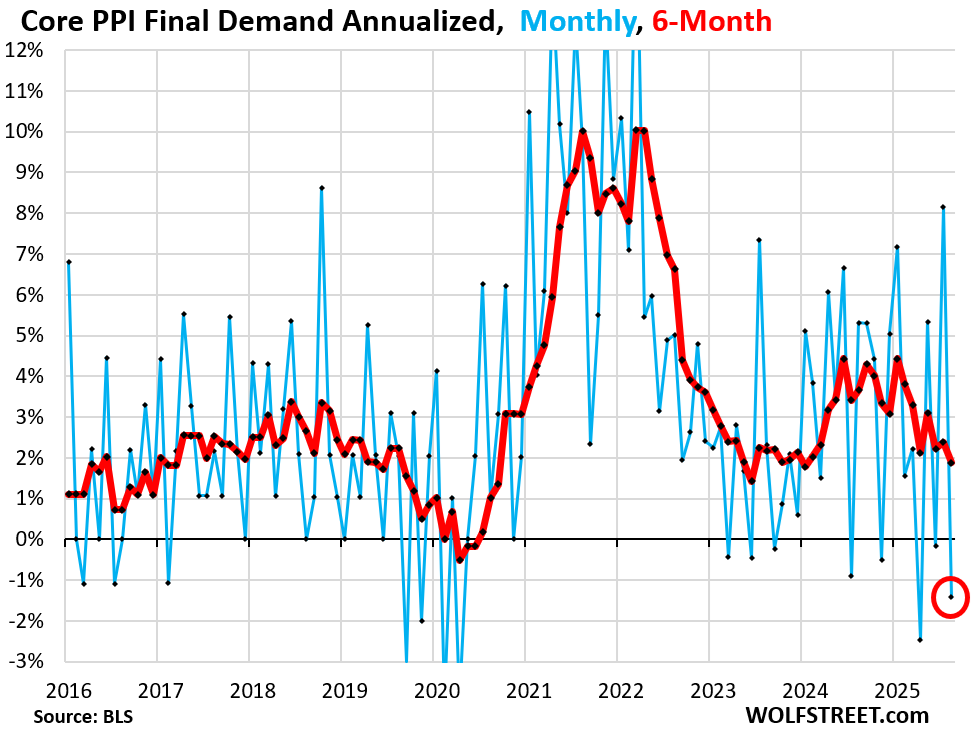
On a year-over-year basis, the core PPI decelerated to +2.8%:
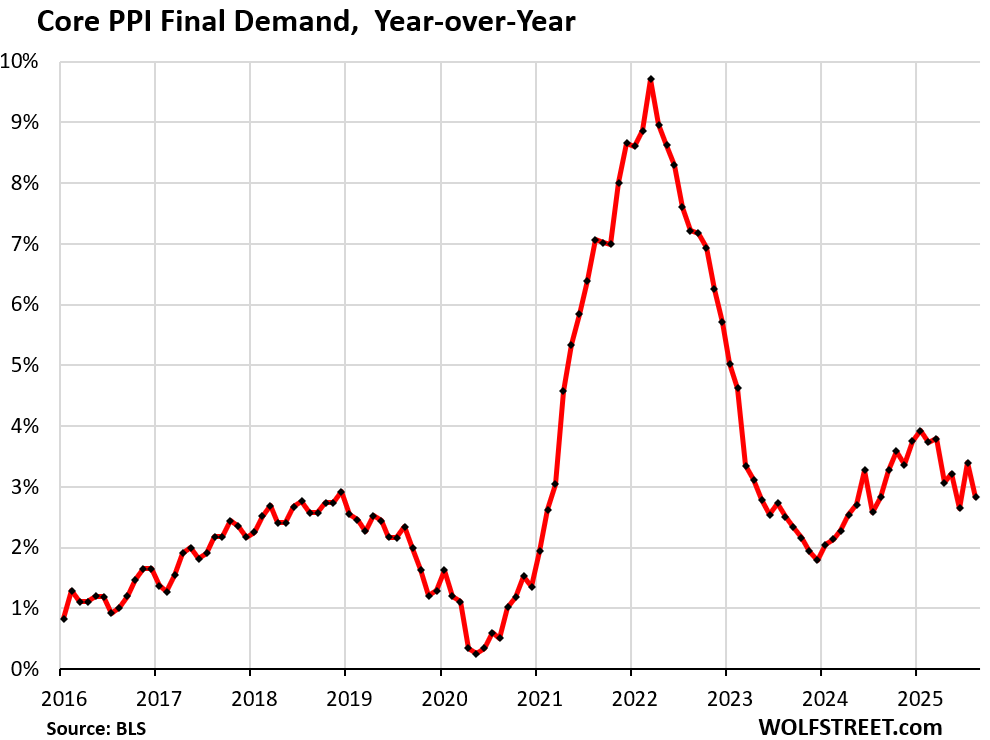
Overall PPI Final Demand was also revised down for July (to +0.70% from +0.94%). And for August, it declined by 0.12% (-1.4% annualized).
Food prices inched up 0.1% month-to-month, but energy prices fell by 0.4%.
The six-month average decelerated to +1.1%.
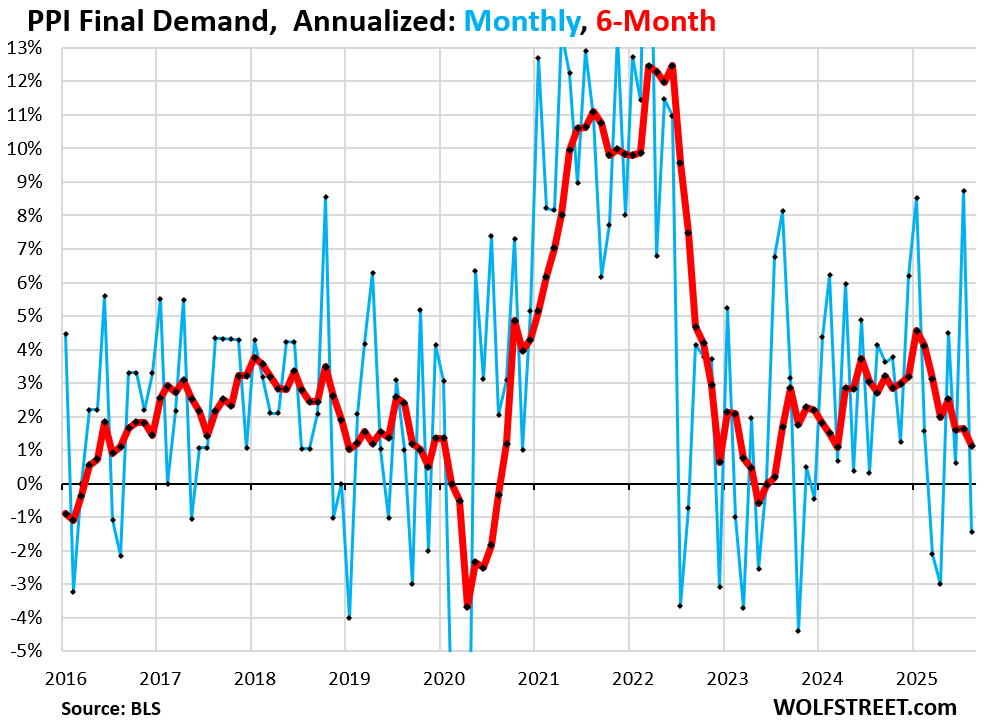
Year-over-year, the PPI Final Demand accelerated to 2.6%. June 2023 marked the low point at near 0%. Since then, in its zigzag manner, the trend has been higher.
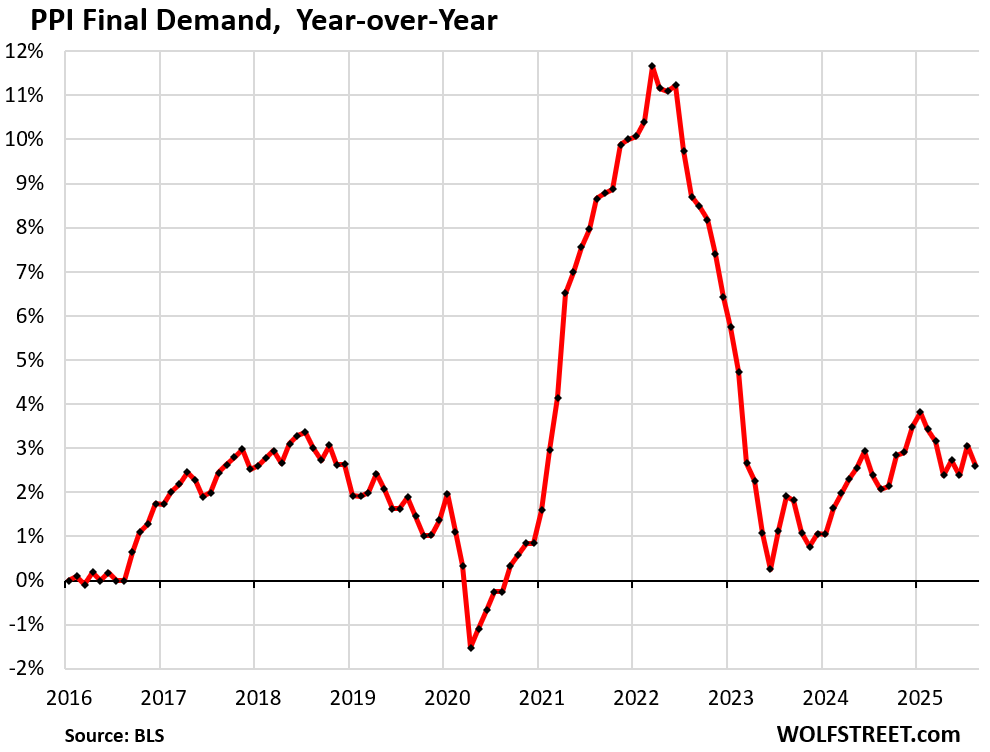
What I expect.
So, just by looking at the month-to-month blue zig-zag lines in these charts, I expect a reversal in a month or two, with a significant spike in the services PPI and possibly an upward revision of the August decline (to less of a decline).
Last fall was full of upward revisions, to where much of the acceleration of the PPI at the time came in the revisions, not in the original data releases, which were relatively benign. During this episode last fall, I started keeping the original data, rather than overwriting it, because the revisions had such a dramatic effect.
Enjoy reading WOLF STREET and want to support it? You can donate. I appreciate it immensely. Click on the mug to find out how:
![]()


Speaking of zizagging.. Larry Ellison of Oracle zagged $110 Billion in his personal worth in one day. Quickly, cut the rates!!
They missed estimates too! The hype was based purely on corporate projections about future cloud revenue.
There are $20 Trillion in SP500 “value” riding on Taiwan Semiconductor making enough chips. Unless we ran out of electricity sooner (heard it on CNBC). Enronization of the US stock market continues unabated.
It’s a non-issue Mish.
I have it on good authority that this inflation stuff is only “transient.”
This needs more attention. I feel like the media has swept that massive blunder under the rug. So many of our inflation problems was due to this false belief that inflation was transitory and subsequently the delay in raising rates.
Whenever I hear an eye-catching financial headline, I always come to Wolf Street to understand the reality and context. Thank you!
Trump has been pretty good about being correct for the most part. He has access to more info than the public does. He also surrounds himself with the smartest people in the entire world.
I’m going with him and betting on inflation going down.
I could be wrong, but he just seems to be right more than wrong.
DTH
I think your kidding but not sure where the workers that are going to provide services are coming from go ask the 475 workers kicked out of the coutry and the goal of 3000 per day to be kicked out. whos going to do the work i am guessing the admin and others think robots well i am from the show me state ny. so show me.
Yes we must keep our slave labor.
What you don’t realize is that a lot of these companies will only employ the illegals. If they employ legal workers, they have to pay the employers share of social security, medicare and take federal, state and local taxes out of their pay. So they employ the illegals, and pay in cash under the table while the rest of us pay all the taxes. Sounds fair to me.
It is not that hard for companies to get temp work visa’s for non-US workers if they can show a need. But if their employee’s have a work visa, then they have to pay the employer portion of social security and withhold taxes, which means they must pay higher wages.
You could be wrong………
If some producers are eating tariffs, and reducing profit margins —- that results in weaker employment, or at least no hiring, which means jobs will get harder to get. On the other hand, some producers are not eating tariffs…
The economy seems perpetually resilient, but its immune system is in for a tuff winter. Stagflation flu?
Or, it means that they’re returning less to shareholders. I’ve always thought it a myth that higher profits means more hiring and investment.
Like most things in capitalism, there needs to be competition, or the profits may well not be deployed in wages and means of production.
Redundant wrote: “If some producers are eating tariffs..”
Consumers in the USA are eating the tariffs. At least for the stuff I buy at the grocery store. I see a 24 oz can of some coffee brands at $21-$23 now (some of the cheaper ones that used to be $6-$8 are still around for $12-$14). But the coffee section is shrinking. What was once a nickel bag (2 oz) of M&M candy (1960’s) is now $1.99. The chocolate truffles I buy my woman was $8 per 12oz, now $16.
I am keeping a wary eye on the produce, dairy, and pasta sections of the store as I am seeing some empty shelves in those areas.
But hey, at least gas at the pump here is $2.72 to $3.19. Wolf can fill you in on what a new ICE will cost you.
That $135.7 billion in customs duties (tariffs) for Fiscal Year 2025 came out of USA pockets, not foreign pockets. Oh well, at least the Corps and Billionaires got a nice tax cut.
Goofball. Commodity prices of coffee have been spiking for four years, and you slept through it, and now you blame the tariffs? I get so tired of this braindead BS about tariffs.
https://wolfstreet.com/2025/09/11/cpi-inflation-dishes-up-another-nasty-surprise-as-it-tends-to-do/
That’s still one of the things that I don’t get about Wolf’s pro-tariff thing; if these companies are actually competing with each other at all then there shouldn’t be a lot of excess profit for them to use to offset the tariffs, and so they’ll have to pass the costs on. If they do have so much excess profit (like 20+ percent, depending on what Trump decided the rate would be when he spun the Wheel-O-Tariffs this morning), then capitalism already isn’t working as intended, and that’s *with* foreign competition. Why do we think it would be any more competitive if we then eliminate foreign competition?
I think it is very important to also include the aggregate index chart….
the total PPI price level rise in total from say 2020.
Just to see how the “fight” on inflation is really going.
Agree. It’s Wolf’s best. That “cumulative” chart shows the disconnect between the headlines and consumer reality. Q: If inflation really is 3%, why are the prices so damn high? A: See the chart; its actually up 30% over 6 years (pre COVID panic). I doubt most 30+ year olds understand this. It’s why they too should read the Wolf.
More blasphemy: Maybe someone will have the courage to bend that cumulative inflation curve? Now cue the howling from the Anti QT and Tariff experts …
Perhaps we should debate:”inflation will not go away until the deficit goes away”. It is to big to be paid off, reducing the dollars purchasing power through inflation will eventually make the deficit of little import.
That assumes that the deficit doesn’t continue to increase each year. You can’t inflate your way out of debt.
The economy seems to be slowing somewhat, and rates are expected to drop to counter it, which in theory, would make risk assets, including stocks, more attractive.
But everyone is all in on stocks (there’s an article on CNBC about family offices increasing their exposure to stocks and decreasing to private equity), which basically means that they think the general slowdown won’t affect the Mag7 which are basically propping up the indices.
In other words, they think BigTech’s “ecosystem” and AI can mean forever growing profits, irrespective of the economy around them.
Are they right? Will advertisers not pull back? Will companies that close not reduce their demand for AWS or Azure? It’s a very interesting dynamic right now.
Private equity is in full blown retreat. It’s massively overvalued and opaque.
The CRB Commodity price index rose.
https://tradingeconomics.com/commodity/crb
Do you have both originally reported and revised that can be plotted against each other? That would make an interesting graph when it comes to reviewing past market sentiment.
I do that occasionally for entertainment purposes, such as for January:
Today’s Inflation is tomorrow’s devalued currency.